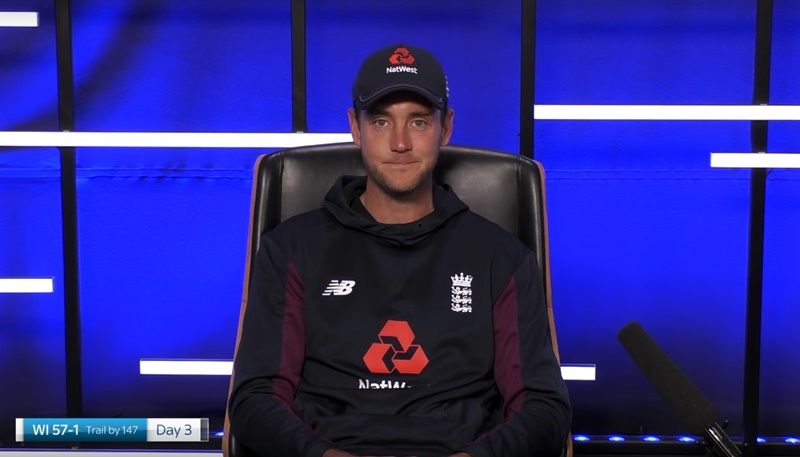Let’s talk about picking bowling attacks. Let’s use the first Test between England and the West Indies as a case study and, for an extra frisson of excitement, let’s do this halfway through the game – that way any specifics we use can turn out to be very wrong.
Because being wrong is what picking a bowling attack is all about.
Let’s start with the West Indies, because they bowled first.
Four seamers

The Windies have settled on a bowling strategy in recent years. Kemar Roach and Jason Holder give the batsmen nothing, while Shannon Gabriel and Alzarri Joseph fire it down with a little more intent. On this occasion they supplemented their pace foursome with the unremarkable finger spin/small West Midlands village of Roston Chase.
In England’s first innings, this line-up did the job. The pace of Gabriel and ludicrous height and lateral movement of Holder hoovered up all the wickets, but the accurate work done by Roach shouldn’t be overlooked. He forced the batsmen to make a lot of difficult decisions and wore them down considerably.
No Stuart Broad
You could say that Ben Stokes and the rest of the England management team picked James Anderson, Jofra Archer and Mark Wood as their pace bowlers for this Test. A more accurate way of putting that would be to say that they didn’t pick Stuart Broad.
A lot of people were angry and confused about this omission – chief among them Broad himself, who had a grand old bitch and moan in Sky Sports’ special lockdown diary room.

Broad is a man we have warmed to more and more as his career has worn on. It’s hard to put our finger on precisely why this is, but it seems to revolve around our coming to appreciate his fundamental Broadness.
On this occasion our man pretty much said that while his team-mates were really good, he was even better and it was stupid to drop him – which is a very Stuart Broad thing to get away with saying.
He did have a point. He’d taken 14 wickets at 19.42 in England’s previous series in South Africa, and the last time England played at home, he’d made David Warner look ridiculous. You’d have thought those efforts alone would have earned him a spot.
Most of us have spent a little too long thinking about one thing or another in recent months and it kind of feels like England have done the same thing. Imagine you have zero time to chew selection over. In that situation, when you’re just naming 11 England players without thinking, your opening bowlers are definitely going to be James Anderson and Stuart Broad.
There aren’t many occasions when you’re playing in the UK when that isn’t a pretty decent way of setting about things.
Archer and Wood duly mustered one wicket between them in the West Indies’ first innings and everyone concluded that Broad would have nibbled a couple more. We imagine he would have.
But then England didn’t bowl badly and Test cricket is a two innings game.
The second innings
At the time of writing, Jason Holder has switched from being a gangly, 80mph, nibbly destroyer to being a gangly, 80mph, nibbly holding bowler (which is more befitting his name). He may switch back, but for now that seems to be where we are.
This is actually one of the reasons why Holder’s such a great cricketer. Regardless of conditions, he is never a weak link. The shift does however highlight that yesterday’s match-winning bowler can easily become today’s support act.
This leaves a gap in the Windies attack. With minimal swing and not so much seam, someone else needs to take the wickets.
This is the challenge of putting together a bowling attack: conditions are rarely constant. If one bowler adapts to a change in circumstances, that’s great – but it may also leave a void that someone else will have to fill.
Who will dismiss England in less Holder-friendly conditions? Roston Chase maybe? He’s done it before – against England, in fact – but other than that one occasion, he doesn’t have a history of spinning teams out single-handed. The Windies would no doubt like to have a second 90mph-plus bowler to supplement Shannon Gabriel, who may find himself blunted through overuse.
And then after that, what of England’s attack? If Archer and Wood scythe through the Windies batsmen and take England to victory, are they second innings saviours or first innings flops? How would you weigh those contrasting contributions?
And related to that, how would you factor in the 25 overs James Anderson ended up bowling in the first innings to allow those two to bowl shorter spells? You’d certainly have to include that aspect as yet another major contribution from Jimmy in the unlikely event the two of them to turn into world-beaters on day five.
An amorphous assault
A good bowling attack is a kind of amorphous multi-coloured slurry. As a captain, you want to be able to smoosh it around and apply different bits of it at different times – only without moving it in such a way that you put a hole in it.
This is, for almost every team, impossible. Whoever you pick, however you combine your bowlers, before too long you will almost certainly bowl your way to a point where one of your weaknesses is exposed. That specific weakness would absolutely 100 per cent definitely have been perfectly covered by a player you haven’t picked.
This is just the way it works. Every bowling attack is wrong. The aim of the game is to be less wrong than the opposition. And also to bat better.




Quite right.
This is such an unusual series too. In a way, all six tests this summer comprise a single, endurance test series for England.
Two and a bit days in to the thing is a bit early for post mortem.
The Sky coverage seems, to me, to be trying to make storms in teacups. I thought Broad’s interview was well balanced. We want him to really care, we don’t want him to rubbish his colleagues. Broad walked that tightrope well, but you wouldn’t have thought so based on some of the stormy adjectives that emerged from the Sky commentary camp.
Tea on day four – match poised and all results still possible. Test cricket. Love it.
Think we’re all out of practise and anxious about finding an angle that’ll warrant a headline.
Quite the last hour
Quite the… second hour?
In Dom Bess we trust to bowl out the West Indies.
Exciting, this.
Stokes has made 1 thing happen. Needs another 5 things please.
This article didn’t age anywhere near as badly as we expected it to.
Who agrees with me on these changes for the 2nd test.
Root for Denly
BROAD for Wood
Foakes for Buttler. Although that probably won’t happen.
https://www.cricket365.com/alex-bowden/four-things-england-hate-even-more-than-ben-foakes/
I’d consider dropping Anderson for Woakes or Curran.
We’d pick Denly ahead of Root, just for the spectacular public response.
And sack Root as captain as well.
An excellent idea, KC.
You remember that Travelator thing on Gladiators in the 90s, that the [apply Scottish accent] contestants had to run up to win? So many of them got nearly to the top and then made some kind of lunge, instead of just carrying on doing what had got them that far up, that being running, and as a consequence ended up in a pile at the bottom.
In the first innings, our batsmen scored 30, 0, 18, 10, 43, 12 and 35. They all did a bit, you know, sort-of OK-ish, but nobody did well. They each ran up the Travelator, then ended up in a pile at the bottom.
In the second innings, our batsmen undid most of this damage, getting level and then ahead without too many wickets down. And exactly at the point when it seemed that England were favourites to win, they lost five for 30 and the match. Collectively this time, they were right at the Travelator top, and then not.
The 90s cultural reference is relevant – this is such a 90s scorecard. It reeks of batting mediocrity, not outright incompetence, while failing to understand that in international sport these things are the same. Successful England teams have been full of county outsiders, slightly left-field picks who were selected for some characteristic, doggedness maybe, that the selectors identified as crucial for test players. This feels like a county cricket selection, like the 90s, where the currency is not a dogged determination, but instead is county runs. It’s like a conveyor belt – such-and-such (*) deserves a go, done all the ground work, scored the runs.
My concern is that the Chairman of Selectors, or whatever his job title is, is cut from exactly this cloth. He was a county stalwart, 12,000 first class runs at 42, given a go at test cricket, half century on debut, 23 runs in his next four innings. This was all in 2003, but only the date stops it from being a 90s career. He is the epitome of the steady-as-you-go approach that results in things being OK, which as we’ve established is the same as rubbish. Which outsider is he going to identify? Which batsman with the rough edges and not necessarily the county runs is he going to be able to pick out from the crowd? So we have the most 90s batting line-up that I’ve seen since… oh, since I don’t know when. And consequently, we have a 90s result.
(*) Not Such, though.
Yup, Bert.
Daisy blames “Peter Perfect” too. But for slightly different reasons. She thinks he has favourites and unfavourites in a “Smith Of The Remove” way, which can cloud the thinking in his supposedly-mega-mind..